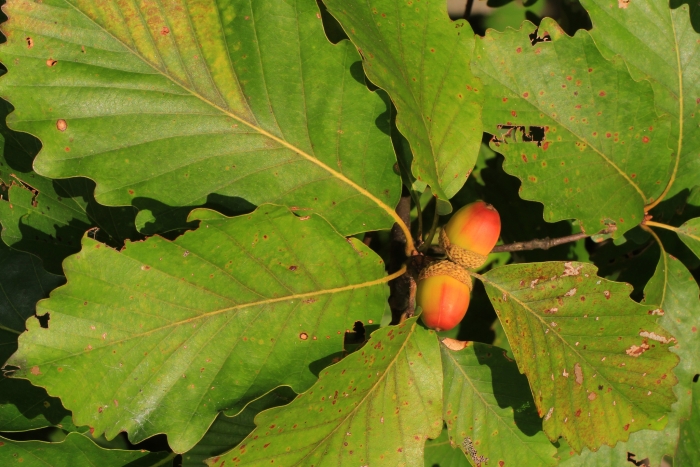Chestnut Oak
(Quercus montana)
Chestnut Oak (Quercus montana)
/
/

Judy Gallagher
CC BY-SA 4.0
Image By:
Judy Gallagher
Recorded By:
Copyright:
CC BY-SA 4.0
Copyright Notice:
Photo by: Judy Gallagher | License Type: CC BY-SA 4.0 | License URL: http://creativecommons.org/licenses/by-sa/4.0/ | Rights Holder: Judy Gallagher | Publisher: iNaturalist | Date Created: 2016-09-23T09:38:49-07:00 |























































Estimated Native Range
Summary
Quercus montana, commonly known as Chestnut Oak, is a deciduous tree native to the upland dry forests, rocky slopes, and ridge tops of the Appalachian Mountains in the Eastern United States. It typically grows to 18–22 meters (59–72 feet) tall, with a similar spread, but under optimal conditions, it can reach impressive heights of 40–43 meters (131–141 feet). The Chestnut Oak is characterized by its thick, deeply furrowed dark gray-brown bark, which is the thickest among eastern North American oaks. Its leaves are similar to those of the American chestnut and emerge in late spring, with staminate flowers appearing in hairy catkins when the leaves are about one-third grown. The acorns, which mature in the fall, are large and a valuable food source for wildlife.
The Chestnut Oak is valued for its ability to thrive in dry, infertile sites where few other trees can survive, making it a sturdy and low-maintenance choice for challenging landscapes. It is often used in reforestation projects and as a canopy species in native plant gardens. The tree’s acorns are also appreciated for wildlife habitat restoration. In cultivation, it prefers full sun but can tolerate partial shade, and it requires well-drained soil. While it is drought-tolerant once established, it benefits from occasional watering during prolonged dry spells.CC BY-SA 4.0
The Chestnut Oak is valued for its ability to thrive in dry, infertile sites where few other trees can survive, making it a sturdy and low-maintenance choice for challenging landscapes. It is often used in reforestation projects and as a canopy species in native plant gardens. The tree’s acorns are also appreciated for wildlife habitat restoration. In cultivation, it prefers full sun but can tolerate partial shade, and it requires well-drained soil. While it is drought-tolerant once established, it benefits from occasional watering during prolonged dry spells.CC BY-SA 4.0
Plant Description
- Plant Type: Tree
- Height: 50-70 feet
- Width: 50-70 feet
- Growth Rate: Slow
- Flower Color: N/A
- Flowering Season: Spring
- Leaf Retention: Deciduous
Growth Requirements
- Sun: Full Sun, Part Shade
- Water: Low
- Drainage: Medium
Common Uses
Bee Garden, Bird Garden, Butterfly Garden, Drought Tolerant, Low Maintenance, Rabbit Resistant, Street Planting
Natural Habitat
Upland dry forests, rocky slopes, and ridge tops of the Appalachian Mountains
Other Names
Common Names: Rock Chestnut Oak, Mountain Chestnut Oak, Kastanjeek
Scientific Names: , Quercus montana, Quercus prinus var. monticola, Quercus longifolia, Quercus prinus var. palustris, Quercus carolineana, Quercus carpinifolia, Quercus granulata, Quercus monticola, Quercus prinus f. viridis
GBIF Accepted Name: Quercus montana Willd.